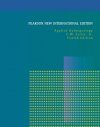Textbook
By: CW Fetter, Jr.(Author)
692 pages, illustrations, maps, tables, includes CD-ROM
![Applied Hydrogeology (International Edition) Applied Hydrogeology (International Edition)]()
Click to have a closer look
About this book
Contents
Customer reviews
Related titles
About this book
The text is designed for advanced undergraduate or beginning graduate-level courses in hydrology, groundwater hydrology, hydrogeology, and civil engineering. This best selling text gives students a balanced examination of all facets of hydrogeology. The text stresses the application of mathematics to problem solving rather than derivation of theory. It provides a balance between physical and chemical hydrogeology. Numerous case studies cultivate student understanding of the occurrence and movement of ground water in a variety of geologic settings.
New to this edition:
- Updated references throughout the new edition.
- Excel-based project included in the ground water modeling chapter.
- Five new case histories: The Dakota Aquifer, Fractures Sedimentary Rocks – Newark basin, Faults as Aquifer Boundaries, Desert Hydrology – Azraq basin, Jordan, and Use of multiple geophysical techniques to determine the extent and thickness of a critical confining layer.
- "Analysis" section in select chapters – Student is directed to a problem or issue that will require independent thought and problem solving techniques illustrated in the solved example problems.
- New Chapter 2, "Elements of the Hydrologic Cycle", combines the old chapters 2 and 3.
- Use of Internet to obtain hydrogeologic data and information.
- Brief introduction to ASTM Standards.
Contents
Glossary
(NOTE: Each chapter concludes with Notation, Analysis, and Problems.)
1. Water
Water. Hydrology and Hydrogeology. The Hydrologic Cycle. Energy Transformations. The Hydrologic Equation. Hydrogeologists. Applied Hydrogeology. The Business of Hydrogeology (What Do Hydrogeologists Do All Day?) Sources of Hydrogeological Information. American Society of Testing and Materials Standards. Working the Problems. Solving Problems Using Spreadsheets.
2. Elements of the Hydrologic Cycle
Evaporation. Transpiration. Evapotranspiration. Condensation. Formation of Precipitation. Measurement of Precipitation and Snow. Effective Depth of Precipitation. Events during Precipitation. Events During Precipitation. Stream Hydrographs. Rainfall-Runoff Relationships. Duration Curves. Determining Ground-Water Recharge from Baseflow. Measurement of Streamflow. Manning Equation.
3. Properties of Aquifers
Matter and Energy (A Brief Review of Physics). Porosity of Earth Materials. Specific Yield. Hydraulic Conductivity of Earth Materials. Permeameters. Water Table. Aquifers. Water-Table and Potentiometric Surface Maps. Aquifer Characteristics. Compressibility and Effective Stress. Homogeneity and Isotropy. Gradient of the Potentiometric Surface.
4. Principles of Ground-Water Flow
Introduction. Mechanical Energy. Hydraulic Head. Head in Water of Variable Density. Force Potential and Hydraulic Head. Darcy's Law. Equations of Ground-Water Flow. Solution of Flow Equations. Gradient of Hydraulic Head. Relationship of Ground-Water-Flow Direction to Grad h. Flow Lines and Flow Nets. Refraction of Flow Lines. Steady Flow in a Confined Aquifer. Steady Flow in an Unconfined Aquifer.
5. Ground-Water Flow to Wells
Introduction. Basic Assumptions. Radial Flow. Computing Drawdown Caused by a Pumping Well. Determining Aquifer Parameters from Time-Drawdown Data. Slug Tests. Estimating Aquifer Transmissivity from Specific Capacity Data. Intersecting Pumping Cones and Well Interference. Effect of Hydrogeologic Boundaries. Aquifer-Test Design.
6. Soil Moisture and Ground-Water Recharge
Introduction. Porosity and Water Content of Soil. Capillarity and the Capillary Fringe. Pore-Water Tension in the Vadose Zone. Soil Water. Theory of Unsaturated Flow. Water-Table Recharge.
7. Regional Ground-Water Flow
Introduction. Steady Regional Ground-Water Flow in Unconfined Aquifers. Transient Flow in Regional Ground-Water Systems. Noncyclical Ground Water. Springs. Geology of Regional Flow Systems. Interactions of Ground Water and Lakes or Wetlands and Streams.
8. Geology of Ground-Water Occurrence
Introduction. Unconsolidated Aquifers. Lithified Sedimentary Rocks. Igneous and Metamorphic Rocks. Ground Water in Permafrost Regions. Ground Water in Desert Areas. Coastal-Plain Aquifers. Fresh-Water-Saline-Water Relations. Tidal Effects. Ground-Water Regions of the United States.
9. Water Chemistry
Introduction. Units of Measurement. Types of Chemical Reactions in Water. Law of Mass Action. Common-Ion Effect. Chemical Activities. Ionization Constant of Water and Weak Acids. Carbonate Equilibrium. Thermodynamic Relationships. Oxidation Potential. Ion Exchange. Isotope Hydrology. Major Ion Chemistry. Presentation of Results of Chemical Analyses.
10. Water Quality and Ground-Water Contamination
Introduction. Water-Quality Standards. Collection of Water Samples. Ground-Water Monitoring. Vadose-Zone Monitoring. Mass Transport of Solutes. Ground-Water Contamination. Ground-Water Restoration. Case History: Ground-Water Contamination at a Superfund Site. Capture-Zone Analysis.
11. Ground-Water Development and Management
Introduction. Dynamic Equilibrium in Natural Aquifers. Ground-Water Budgets. Management Potential of Aquifers. Paradox of Safe Yield. Water Law. Artificial Recharge. Protection of Water Quality in Aquifers. Ground-Water Mining and Cyclic Storage. Conjunctive Use of Ground and Surface Water. Global Water Issues.
12. Field Methods
Introduction. Fracture-Trace Analysis. Surficial Methods of Geophysical Investigations. Geophysical Well Logging. Hydrogeologic Site Evaluations. Responsibilities of the Field Hydrogeologist. Project Reports.
13. Ground-Water Models
Introduction. Applications of Ground-Water Models. Data Requirements for Models. Finite-Difference Models. Finite-Element Models. Use of Published Models. MODFLOW Basics. Visual MODFLOW. Geographical Information Systems.
Appendices
Answers
Refernces
Index
Customer Reviews
Textbook
By: CW Fetter, Jr.(Author)
692 pages, illustrations, maps, tables, includes CD-ROM
































![The Nature and Properties of Soils [Global Edition]](http://mediacdn.nhbs.com/jackets/jackets_resizer_medium/22/229384.jpg?height=150&width=116)

